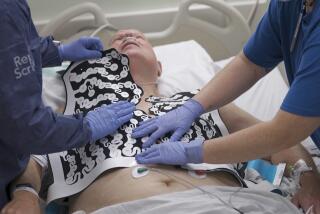Fringe therapy may help heart patients, study finds
A treatment that removes heavy metals from the body has long been touted as an alternative therapy to combat hardening arteries. Now a 10-year, $31-million clinical trial has found that chelation therapy does help heart attack patients slightly reduce their risk of serious heart problems — but not enough for the researchers to encourage mainstream cardiologists to offer it to their patients.
The trial revealed a very modest benefit for patients who took chelation therapy rather than a placebo, according to results published Wednesday in the Journal of the American Medical Assn.
The findings came in for harsh criticism by other experts who worried that the results might encourage patients to take up a still unproven and potentially dangerous treatment.
“It’s a type of medical quackery that has been around for many decades,” said Dr. Steven Nissen, chair of cardiovascular medicine at the Cleveland Clinic in Ohio.
Chelation therapy was introduced around World War II as an antidote against an arsenic-based poison gas called Lewisite. The drug tested in the JAMA study — called ethylenediamine-tetraacetic acid, or EDTA — was used to treat lead poisoning in Navy personnel who repainted ships’ hulls.
About 50 years ago, it came into vogue as an apparent way to remove mineral-rich deposits of plaque that can cause arteries to harden in a condition known as atherosclerosis.
Though still on the fringe, chelation therapy has been gaining traction: A National Center for Health Statistics report estimated that 111,000 patients had the expensive, time-consuming therapy in 2007 — a 68% jump from 2002. Patients clearly needed more information about this unproven treatment, said Dr. Judith Hochman, a cardiologist at New York University who was not involved in the study.
“There was an imperative to study it,” Hochman said.
The National Center for Complementary and Alternative Medicine and the National Heart, Lung and Blood Institute — two branches of the National Institutes of Health — agreed to fund it. Researchers from 134 facilities agreed to administer a cocktail comprising disodium EDTA, vitamins and electrolytes or a placebo to 1,708 patients who were at least 50 years old and had suffered a heart attack at least six weeks earlier. The 40 infusions were spread out over more than a year.
The researchers found that chelation did reduce patients’ overall risk of heart problems, such as stroke and angina requiring hospitalization. Chelation patients’ heart attack rate was 6%, compared with 8% for those on the placebo.
The strongest effect was seen with procedures to reopen the coronary artery: 15% of chelation patients needed them, compared with 18% of patients who got the placebo treatment. The difference was small, but it was just enough to be statistically significant, said Dr. Gervasio Lamas, the Columbia University cardiologist who led the study.
“I can’t overemphasize how unexpected these results were,” he said.
But the clinical trial was beset by a host of problems, said Nissen, who wrote an editorial in JAMA that was deeply critical of the study. Many of the patients dropped out of the trial, thus weakening the results, he said. What’s more, some of the patients were treated in alternative medicine centers that sold unproven remedies such as aromatherapy and crystal therapy.
“How do you get good research done at places like that?” Nissen said. “I think you don’t.”
In addition, the Office for Human Research Protections in the Department of Health and Human Services launched an investigation, mentioning — among several other concerns — that a few researchers had been involved in insurance fraud and three were convicted felons.
Lamas said all researchers were thoroughly trained for their duties, whether they were doctors experienced in clinical trials or alternative medicine practitioners with expertise in chelation treatments. He also said some patients were bound to drop out of a study that was so time-consuming. (Each infusion lasted several hours.)
JAMA Editor in Chief Howard Bauchner said the study was put through the wringer before it was published, with the results vetted by a team of cardiologists, statisticians and other researchers. It deserved to be published regardless of negative attitudes toward the paper, he said.
But the findings are far from definitive, Hochman said: “The therapy’s not ready for prime time.”
Dr. Harlan Krumholz, a Yale University cardiologist who was not involved in the study, said that any apparent benefits to chelation would be hard for physicians to swallow.
“A lot of people thought this would be a good study because it would be a chance to disprove a therapy that had little support among mainstream academics,” Krumholz explained. “It’s a terrific group of investigators who’ve addressed an interesting question, who’ve come up with a surprising result that nobody knows what to do with.”






